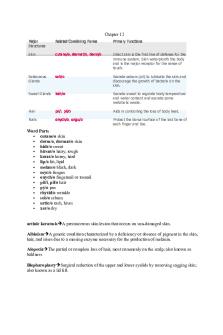Flashcards Chapter 12 - Flashcards Chapter 12 PDF

| Title | Flashcards Chapter 12 - Flashcards Chapter 12 |
|---|---|
| Course | Introduction to Psychology |
| Institution | New Mexico State University |
| Pages | 1 |
| File Size | 46 KB |
| File Type | |
| Total Downloads | 92 |
| Total Views | 160 |
Summary
Flashcards based on chapter 12 for NMSU intro to psych...
Description
Term
Description
Personal attributions
People's explanations for why events or actions occur that refer to people's internal characteristics, such as abilities, traits, moods, or efforts. (page 466)
Situational attributions
People's explanations for why events or actions occur that refer to external events, such as the weather, luck, accidents, or other people's actions. (page 466)
Fundamental attribution error
In explaining other people's behavior, the tendency to overemphasize personality traits and underestimate situations. (page 466)
Actor/observer bias
When interpreting our own behavior, the tendency to focus on situations rather than personality traits. (page 466)
Self-fulfilling prophecy
People's tendency to behave in ways that confirm their own expectations or other people's expectations. (page 469)
Prejudice
Negative feelings, opinions, and beliefs associated with a stereotype. (page 469)
Discrimination
The inappropriate and unjustified treatment of people based on the groups they belong to. (page 469)
Modern racism
Subtle forms of prejudice that coexist with the rejection of racist beliefs. (page 470)
Attitudes
People's evaluations of objects, of events, or of ideas. (page 472)
Attitude accessibility
Ease or difficulty of retrieving an attitude from memory. (page 472)
Mere exposure effect
The increase in liking due to repeated exposure. (page 472)
Explicit attitude
An attitude that a person is consciously aware of and can report. (page 474)
Implicit attitude
An attitude that influences a person's feelings and behavior at an unconscious level. (page 474)
Cognitive dissonance
An uncomfortable mental state due to a contradiction between two attitudes or between an attitude and a behavior. (page 475)
Persuasion
The active and conscious effort to change an attitude through the transmission of a message. (page 477)
Central route
A method of persuasion that uses high elaboration -- where people pay attention to the arguments and consider all the information in the message. This method usually results in development of stronger attitudes. (page 477)
Peripheral route
A method of persuasion that uses low elaboration -- where people minimally process the message. This method usually results in development of weaker attitudes. (page 477)
Social facilitation
When the mere presence of others improves performance. (page 479)
Social loafing
The tendency for people to work less hard in a group than when working alone. (page 479)
Deindividuation
A state of reduced individuality, reduced self-awareness, and reduced attention to personal standards; this phenomenon may occur when people are part of a group. (page 480)
Conformity
The altering of your own behaviors and opinions to match those of other people or to match other people's expectations. (page 481)
Social norms
Expected standards of conduct, which influence behavior. (page 482)
Compliance
The tendency to agree to do things requested by others. (page 483)
Obedience
When a person follows the orders of a person of authority. (page 484)
Aggression
Any behavior that involves the intention to harm someone else. (page 486)
Frustration-aggression hypothesis
The idea that the more frustrated a person feels, the more likely the person is to act aggressively. (page 487)
Prosocial
Acting in ways that tend to benefit others. (page 488)
Altruism
The act of providing help when it is needed, with no apparent reward for doing so. (page 489)
Bystander intervention effect
The failure to offer help to people in need. (page 489)
Passionate love
A type of romantic relationship that includes intense longing and sexual desire. (page 494)
Companionate love
A type of romantic relationship that includes strong commitment to supporting and caring for a partner. (page 494)...
Similar Free PDFs

Chapter 9 Flashcards Chegg
- 15 Pages

Chapter 7 Flashcards Quizlet
- 8 Pages

Chapter 8 Flashcards Quizlet
- 11 Pages

Chapter 9 Flashcards Quizlet
- 7 Pages

Chapter 8 marketing Flashcards
- 28 Pages

MGMT chapter. 17 Flashcards
- 6 Pages

Chapter 16 Flashcards Quizlet
- 4 Pages

Chapter 19 Flashcards Quizlet
- 4 Pages

Chapter 12
- 14 Pages

Chapter 12
- 20 Pages
Popular Institutions
- Tinajero National High School - Annex
- Politeknik Caltex Riau
- Yokohama City University
- SGT University
- University of Al-Qadisiyah
- Divine Word College of Vigan
- Techniek College Rotterdam
- Universidade de Santiago
- Universiti Teknologi MARA Cawangan Johor Kampus Pasir Gudang
- Poltekkes Kemenkes Yogyakarta
- Baguio City National High School
- Colegio san marcos
- preparatoria uno
- Centro de Bachillerato Tecnológico Industrial y de Servicios No. 107
- Dalian Maritime University
- Quang Trung Secondary School
- Colegio Tecnológico en Informática
- Corporación Regional de Educación Superior
- Grupo CEDVA
- Dar Al Uloom University
- Centro de Estudios Preuniversitarios de la Universidad Nacional de Ingeniería
- 上智大学
- Aakash International School, Nuna Majara
- San Felipe Neri Catholic School
- Kang Chiao International School - New Taipei City
- Misamis Occidental National High School
- Institución Educativa Escuela Normal Juan Ladrilleros
- Kolehiyo ng Pantukan
- Batanes State College
- Instituto Continental
- Sekolah Menengah Kejuruan Kesehatan Kaltara (Tarakan)
- Colegio de La Inmaculada Concepcion - Cebu





